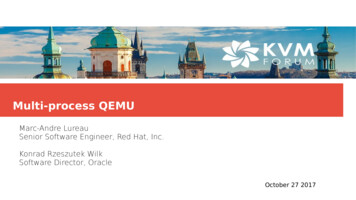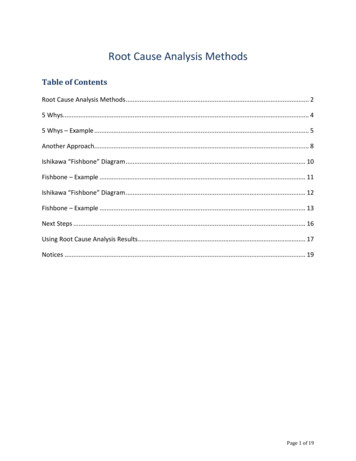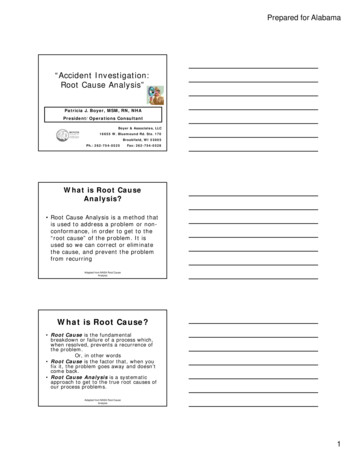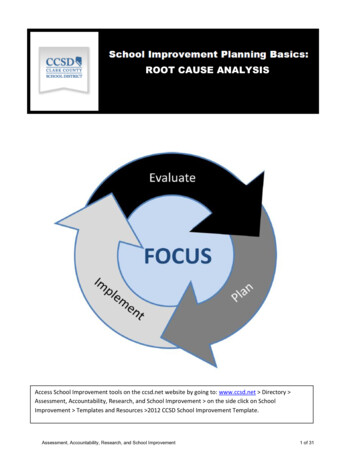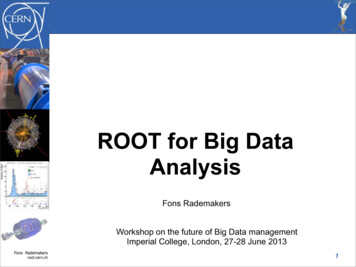
Transcription
ROOT for Big DataAnalysisFons RademakersWorkshop on the future of Big Data managementImperial College, London, 27-28 June 2013Fons Rademakersroot.cern.ch1
HEP’s Core Competency Handling, processing and analyzing “Big Data” For the previous (popular) trends, Grid and Clouds,we were buyers For this Big Data trend we have something to offer Industry is now reinventing the wheel we started todevelop almost 20 years ago as HEP data sizes arebecoming more commonImperial College Workshop27-28 June 20132
Industry Catching Up Map-Reduce (Hadoop)– Parallel batch solution for analyzing unstructured data Dremel (Drill)– Interactive analysis of structured nested data stored incolumnar format SciDB– Parallel analysis of matrix data stored in a DB Several commercial offeringsImperial College Workshop27-28 June 20133
Google’s Dremel Dremel: Interactive Analysis of Web-Scale Datasets“Dremel is a scalable, interactive ad-hoc query system for analysis ofread-only nested data. By combining multi-level execution trees and [anovel] columnar data layout, it is capable of running aggregation queriesover trillion-row tables in seconds. The system scales to thousands ofCPU’s and petabytes of data.”Imperial College Workshop27-28 June 20134
Google’s Dremel Dremel: Interactive Analysis of Web-Scale Datasets“Dremel is a scalable, interactive ad-hoc query system for analysis ofread-only nested data. By combining multi-level execution trees and [anovel] columnar data layout, it is capable of running aggregation queriesover trillion-row tables in seconds. The system scales to thousands ofCPU’s and petabytes of data.”Sounds pretty much like ROOTImperial College Workshop27-28 June 20134
The ROOT System ROOT is a extensive data handling and analysis framework– Efficient object data store scaling from KB’s to PB’s– C interpreter– Extensive 2D 3D scientific data visualization capabilities– Extensive set of data fitting, modeling and analysis methods– Complete set of GUI widgets– Classes for threading, shared memory, networking, etc.– Parallel version of analysis engine runs on clusters and multicore– Fully cross platform, Unix/Linux, Mac OS X and Windows– 2.7 million lines of C , building into more than 100 shared libs Development started in 1995 Licensed under the LGPLImperial College Workshop27-28 June 20135
ROOT - In Numbers of Users Ever increasing number of users– 6800 forum members, 68750 posts, 1300 on mailing list– Used by basically all HEP experiments and beyondImperial College Workshop27-28 June 20136
ROOT - In PlotsImperial College Workshop27-28 June 20137
700600s 7 TeV, Ldt 1 fb -1CMS Preliminaryτ LSPm1/2 (GeV/c2)ROOT - In Plots (1q250)GeV2010 Limits0500 LEP2 l g (1250)GeV (q1000)GeV)GeSSV95% CL limit on σ/σSM300CLs ObservedCLs Expected (68%)CLs Expected (95%)Bayesian ObservedAsymptotic CLs Obs.2000Jets MHTMT2Razor (0.8 fb-1)1 Leptonq (750CMS Preliminarys 7 TeVL 4.6-4.8 fb-1 LEP2 χ1tanβ 10, A 0, µ 040010CDF g, q, tanβ 5, µ 0 D0 g , q, tanβ 3, µ 02011 Limitsg (1000)GeVαTDileptonOS Dileptonq (500)GeV200q (250)GeVg (750)GeVMulti-Lepton(2.1 fb-1)400g (500)GeV6008001000m0 (GeV/c2)110-1110 115 120 125 130 135 140 145Higgs boson mass (GeV)Imperial College Workshop27-28 June 20137
ROOT - On iPadImperial College Workshop27-28 June 20138
ROOT - In Numbers of Bytes StoredAs of today177 PBof LHC datastored in ROOT formatALICE: 30PB, ATLAS: 55PB, CMS: 85PB, LHCb: 7PBImperial College Workshop27-28 June 20139
The Importance of the C Interpreter The CINT C interpreter is the core of ROOT for:– Parsing and interpreting code in macros and oncommand line– Providing class reflection information– Generating I/O streamers and columnar layout We are moving to a new Clang/LLVM basedinterpreter called Clingbash rootroot [0] TH1F *hpx new TH1F("hpx","This is the px distribution",100,-1,1);root [1] for (Int t i 0; i 25000; i ) hpx- Fill(gRandom- Rndm());root [2] hpx- Draw();bash cat script.C{TH1F *hpx new TH1F("hpx","This is the px distribution",100,-1,1);for (Int t i 0; i 25000; i ) hpx- Fill(gRandom- Rndm());hpx- Draw();}bash rootroot [0] .x script.CImperial College Workshop27-28 June 201310
ROOT Object Persistency Scalable, efficient, machine independent format Orthogonal to object model– Persistency does not dictate object model Based on object serialization to a buffer Automatic schema evolution (backward and forwardcompatibility) Object versioning Compression Easily tunable granularity and clustering Remote access– HTTP, HDFS, Amazon S3, CloudFront and Google Storage Self describing file format (stores reflection information) ROOT I/O is used to store all LHC data (actually all HEP data)Imperial College Workshop27-28 June 201311
ROOT I/O in JavaScript Provide ROOT file access entirely locally in a browser– ROOT files are self describing, the “proof of the pudding.”Imperial College Workshop27-28 June 201312
Object Containers - TTree’s Special container for very large number of objects ofthe same type (events) Minimum amount of overhead per entry Objects can be clustered per sub object or even persingle attribute (clusters are called branches) Each branch can be read individually– A branch is a columnImperial College Workshop27-28 June 201313
TTree - Clustering per ObjectTree entriesStreamerBranchesTree in memoryFileImperial College Workshop27-28 June 201314
TTree - Clustering per AttributeStreamerObject inmemoryFileImperial College Workshop27-28 June 201315
Processing a TTreeTSelectorOutput listProcess()Begin()- Create histograms- Define output listpreselectionEventLeafLeafLeaf1nBranchLeaf- Finalize analysis(fitting, .)analysisBranchBranchTTreeOkTerminate()Read needed parts onlyBranchLeafLeafLeaf2nlastLoop over eventsImperial College Workshop27-28 June 201316
TSelector - User Code// Abbreviated versionclass TSelector : public TObject {protected:TList *fInput;TList );voidSlaveBegin(TTree *);Bool t Process(int rial College Workshop27-28 June 201317
TSelector::Process().// select eventb nlhk- GetEntry(entry);b nlhpi- GetEntry(entry);b ipis- GetEntry(entry); ipis--;b njets- GetEntry(entry);ifififif(nlhk[ik] 0.1)(nlhpi[ipi] 0.1)(nlhpi[ipis] 0.1)(njets LSE;// selection made, now analyze eventb dm d- GetEntry(entry);//read branch holding dm db rpd0 t- GetEntry(entry);//read branch holding rpd0 tb ptd0 d- GetEntry(entry);//read branch holding ptd0 d//fill some histogramshdmd- Fill(dm d);h2- Fill(dm d,rpd0 t/0.029979*1.8646/ptd0 d);.Imperial College Workshop27-28 June 201318
RAW - Using SQL to Query TTree’s Developed at DIAS lab @ EPFL SQL makes querying easySELECT eventFROM root:/data1/mbranco/ATLAS/*.rootWHERE( event.EF e24vhi medium1 OR event.EF e60 medium1 ORevent.EF 2e12Tvh loose1 OR event.EF mu24i tight ORevent.EF mu36 tight OR event.EF 2mu13) ANDevent.muon.mu ptcone20 0.1 * event.muon.mu pt ANDevent.muon.mu pt 20000. ANDABS(event.muon.mu eta) 2.4 AND . SQL makes querying fast– Column-stores & vectorized execution use h/w efficiently.Imperial College Workshop27-28 June 201319
PROOF - The Parallel Query Engine A system for running ROOT queries in parallel on a largenumber of distributed computers or many-core machines PROOF is designed to be a transparent, scalable andadaptable extension of the local interactive ROOT analysissession Extends the interactive model to long running “interactivebatch” queries Uses xrootd for data access and communicationinfrastructure For optimal CPU load it needs fast data access (SSD, disk,network) as queries are often I/O bound Can also be used for pure CPU bound tasks like toy MonteCarlo’s for systematic studies or complex fitsImperial College Workshop27-28 June 201320
The PROOF ApproachPROOF clusterFile catalogStorageQueryPROOF query:data file list, mySelector.CSchedulerCPU’sFeedback,merged final output MasterCluster perceived as extension of local PC Same macro and syntax as in local sessionMore dynamic use of resourcesReal-time feedbackAutomatic splitting and mergingImperial College Workshop27-28 June 201321
PROOF - A Multi-Tier ArchitectureWorkersAdapts to wide areavirtual clustersGeographically separateddomains, heterogeneousmachinesNetwork performanceLess importantVERY importantOptimize for data locality or high bandwidth data server accessImperial College Workshop27-28 June 201322
From xrootd/xpdPROOFWorkerTCP/IPUnix SocketNodeImperial College Workshop27-28 June 201323
To PROOF OOFWorkerUnix SocketNodeImperial College Workshop27-28 June 201324
Benchmarking withPROOF-LiteBenchmarkingwithPROOF-LiteRAMCPU testIntel Xeon E7-4870 2.4 GHz4 sockets, hyper-threading80 cores, 125 GB RAMM. Botezatu / OpenLabHDD, SSDSAS, SSD (CMS data)SSDSSDSASHDDBarbone, Donvito, Pompilii CHEP2012Imperial College Workshop27-28 June 201325
PROOF on Demand Use PoD to create a temporary dedicated PROOFcluster on batch resources Uses an Resource Management System to startdaemons– Master runs on a dedicated machine– Easy installation– RMS drivers as plug-ins: gLite, PanDa, HTCondor, PBS,LSF, OGE– ssh plug-in to control resource w/o and RMS Each user gets a private cluster– Sandboxing, daemon in single-user mode (robustness)– Scheduling, auth/authz done by RMSImperial College Workshop27-28 June 201326
PROOF on Clouds A lot of computing resources available via clouds asvirtual machines Several PROOF tests has been made on clouds– Amazon EC2, Google CE (ATLAS/BNL)– Frankfurt Cloud (GSI) Dedicated CernVM Virtual Appliance with therelevant services to deploy PROOF on cloudresources– PROOF Analysis Facility As A ServiceImperial College Workshop27-28 June 201327
ROOT Roadmap Current version is v5-34-05– It is an LTS (Long Term Support) version– New features will be back ported from the trunk Version v6-00-00 is scheduled for when it is ready– It will be Cling based– It will not contain anymore CINT/Reflex/Cintex– GenReflex will come in 6-02– It might not have Windows support (if not, likely in 6-02)– Several “Technology Previews” will be made available Can be used to start porting v5-34 to v6-00Imperial College Workshop27-28 June 201328
Conclusions HEP has a long experience in Big Data We have a number of interesting products on offer We should make a concerted effort to better promoteand market our products EU Big Data projects could be used to extend anddocument our products for a much wider communityImperial College Workshop27-28 June 201329
ROOT is a extensive data handling and analysis framework -Efficient object data store scaling from KB's to PB's -C interpreter -Extensive 2D 3D scientific data visualization capabilities -Extensive set of data fitting, modeling and analysis methods -Complete set of GUI widgets -Classes for threading, shared memory .


